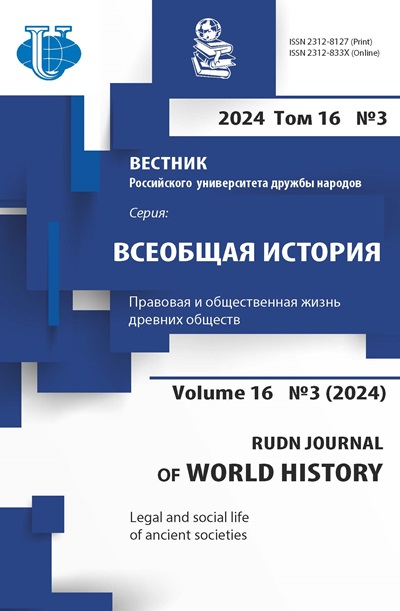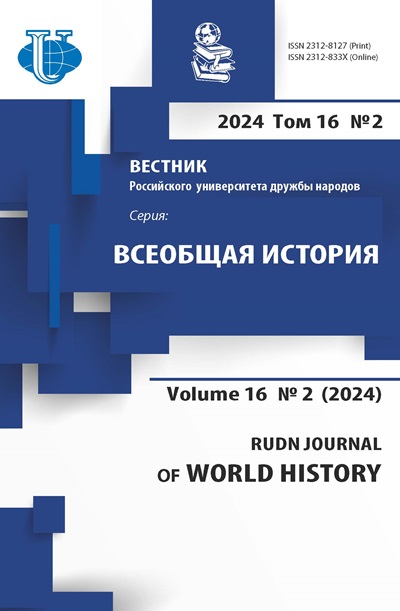Militarization of Culture during Park Chung-hee’s Rule (1961-1979): Focus on South Korean War Movies
- Authors: Starshinov A.S.1
-
Affiliations:
- Lomonosov Moscow State University
- Issue: Vol 16, No 2 (2024)
- Pages: 165-186
- Section: Oriental Studies
- URL: https://journals.rudn.ru/world-history/article/view/40242
- DOI: https://doi.org/10.22363/2312-8127-2024-16-2-165-186
- EDN: https://elibrary.ru/EUWZGW
Cite item
Full Text
Abstract
The study aims to identify the characteristics of South Korean war films as a component of the militarization of culture during Park Chung-hee’s rule (1961-1979). The surge in the popularity of war cinema in the 1960s stemmed from state film policies aimed at fostering the production and consumption of such films, along with heightened interest from both audiences and film companies. However, as the 1960s progressed, state intervention in the film industry increasingly influenced the production dynamics of war films, precipitating a decline in their quality and commercial success at the box office. By the 1970s, war cinema, having lost its appeal, sustained itself solely through government backing. One of the primary features of war cinema was its methods of depicting “us” and “them”. From the state’s standpoint, the ideologically sound portrayal of the enemy in war cinema entailed a dehumanized depiction of the communists, primarily North Korean soldiers, illustrating their brutality and aggression towards South Korean citizens. Such state’s requirement, however, was paradoxical: on the one hand, the shared Korean identity theoretically allowed for the humanization of North Korean soldiers, on the other hand, their portrayal as strong adversaries committing cruel acts risked glorifying their militarized masculinity, a scenario the state sought to avoid. To reconcile this contradiction, film companies employed a strategy of their de-characterization, stripping them of individual traits and relegating to secondary roles on the periphery of the film narrative. In contrast, South Korean soldiers were portrayed as heroic figures, characterized by their individuality and robust masculinity.
Keywords
About the authors
Alexander S. Starshinov
Lomonosov Moscow State University
Author for correspondence.
Email: alex.starshinov@gmail.com
ORCID iD: 0000-0001-9169-1414
SPIN-code: 7549-3100
ResearcherId: GOH-1207-2022
postgraduate student at the Institute of Asian and African Studies
11 Mokhovaya St, Moscow, 125009, Russian FederationReferences
- Je-yeon. Byeongyeong sahoewa gunsajuui munhwa. [The Barracks Society and the Culture of Militarism]. In Hangug hyeondae saenghwalmunhwasa 1960nyeondae: geundaehwawa geundaehwa. [History of everyday Life in the Republic of Korea; 1960s: Modernization and Militarization]. Seoul: Changbi; 2016, p. 191–212. (In Korean)
- Moon S. Militarized Modernity and Gendered Citizenship in South Korea. durham, N.C.: duke University Press; 2005.
- Lee Hana. 1950~60nyeondae bangongjuui damnongwa gamseong jeongchi. [Anticommunist discourse and Politics of Affect]. Sahoewa yeoksa. 2012;95:201–241. (In Korean)
- Yu Seung-jin. Bangongui gamgakgwa buronui jeongchihag — Park Chung-hee cheje haui bangong yeonghwareul ingneun bangbeomnone daehan gochal. [A Sense of AntiCommunism and the Politics of Subversiveness — A Study on How to Read Anti-Communist Films under Park Chung-hee’s Regime]. Daejung seosa yeongu. 2015;21(2):451–487. (In Korean) https://doi.org/10.18856/jpn.2015.21.2.014
- Moon S. Begetting the Nation: The Androcentric discourse of National History and Tradition in South Korea. In Kim e., Choi C, editors. Dangerous Women: Gender and Korean Nationalism. New York: Routledge; 1997, p. 33–66.
- Willems E. A Way of Life and Death: Three Centuries of Prussian-German Militarism: An Anthropological Approach. Nashville, Tenn.: Vanderbilt University Press; 1986.
- Yeom Chan-hee. 1960nyeondae hangugyeonghwaui ‘geundaejeong gugmin’ hyeongseonggwajeong. [1960s’ Korean Films and the Process of the Formation of the Modern Nation]. Yeonghwa yeongu. 2007;33:11–42. (In Korean) https://doi.org/10.17947/ kfa..33.200709.001
- Lee Young-il. Hangug yeonghwa jeonsa. [Complete History of Korean Cinema]. Seoul: Sodo; 2004. (In Korean)
- Basinger J. World War II Combat Film: The Anatomy of a Genre. New York: Columbia University Press; 1986.
- Chung Young-kwon. Hangug bangong yeonghwaui jedohwa yeongu: 1949~1968 jeonjaeng yeonghwawaui jeophab gwajeongeul jungsimeuro. [A Study on the Institutionalization of South Korean Anticommunist Films―Focusing on the Articulation with War Film between 1949 and 1968]. [dissertation]. Seoul; 2010. (In Korean)
- Diffrient D. ‘Military enlightenment’ for the Masses: Genre and Cultural Intermixing in South Korea’s Golden Age War Films. Cinema Journal. 2005;45(1):22–49.
- Shim A. Anticommunist War Films of the 1960s and the Korean Cinema’s early Genre-bending Traditions. Acta Koreana. 2011;14(1):175–196. https://doi.org/10.18399/ acta.2011.14.1.008.
- Yeonghwabeop. [Motion Picture Law]. 1962. Available from: https://www.law.go.kr/LSW/ lsInfoP.do?lsiSeq=5211#0000. [Accessed: 12.08.2023] (In Korean)
- Yeonghwabeop. [Motion Picture Law]. 1963. Available from: https://www.law.go.kr/LSW/ lsInfoP.do?lsiSeq=5212&ancYd=19630312&ancNo= 01305&efYd=19630312&nwJoYnInfo=N&efGubun=Y&chrClsCd=010202&ancYnChk=0#0000. [Accessed: 12.08.2023] (In Korean)
- Boggs C. The Hollywood War Machine: U.S. Militarism and Popular Culture. 2nd ed. New York: Routledge; 2016.
- nyeondae munhwayeonghwaui teukjing. [Features of Cultural Films of the 1960s]. Gukga girok poteol. Available from: https://theme.archives.go.kr/next/movie/features03. do [Accessed: 12.08.2023] (In Korean)
- Gukgaboanbeop. [National Security Act]. 1962. Available from: https://www.law.go.kr/ LSW//lsInfoP.do?lsiSeq=7226&ancYd= 19620924&ancNo=01151&efYd=19621025&nwJoYnInfo=N&efGubun=Y&chrClsCd=010202&ancYnChk=0#0000. [Accessed: 12.08.2023] (In Korean)
- Bangongbeop. [Anti-Communism Law]. 1961. Available from: https://www.law.go.kr/ LSW//lsInfoP.do?lsiSeq=3534&ancYd= 19610703&ancNo=00643&efYd=19610703&nwJoYnInfo=N&efGubun=Y&chrClsCd=010202&ancYnChk=0#0000. [Accessed: 12.08.2023] (In Korean)
- Bangonggwa geomyeol (1955~1970). [Anti-Communism and Censorship (1955~1970)]. KMDb. Available from: https://www.kmdb.or.kr/collectionlist/detail/view?colId=581 [Accessed: 12.08.2023] (In Korean)
- Yeonghwawa sasangseong. [Cinema and Ideology]. Kyunghyang Shinmun. 1965, Feb 8. (In Korean)
- Kim Jimi. Park Chung-hee sidaeui ‘minjok’ damnongwa Lee Man-hee yeonghwaui ‘minjok’ pyosang. [A Study on Representation of ‘Nation’ in Lee Man-hee’s Films during Park Chung-hee’s Rule]. Hanguk hyeondae munhak yeongu. 2013;41:533–568. (In Korean) https://doi.org/10.22871/mklite.2013..41.016
- Chung S. Split Screen Korea: Shin Sang-ok and Postwar Cinema. Minneapolis: University of Minnesota Press; 2014.
- Yeonghwabeop. [Motion Picture Law]. 1966. Available from: https://www.law.go.kr/LSW/ lsInfoP.do? lsiSeq=5213&ancYd=19660803&ancNo=01830&efYd=19660903&nwJoYnInfo=N&efGubun=Y&chrClsCd=010202&ancYnChk=0#0000. [Accessed: 12.08.2023] (In Korean)
- Kim dong-ho et al. Hangug yeonghwa jeongchaeksa. [History of South Korean Film Policy]. Seoul: Nanam; 2005. (In Korean)
- Yeonghwabeop. [Motion Picture Law]. 1973. Available from: https://www.law.go.kr/LSW/ lsInfoP.do?lsiSeq=5215#0000. [Accessed: 12.08.2023] (На корейском языке)
- Jeong Seong-il. Jeungeon. [“Testimony”]. KMDb. Available from: https://www.kmdb. or.kr/story/5/1344 [Accessed: 12.08.2023] (In Korean)
- Jeong Seong-il. Ulji Aneuri. [“I Won’t Cry”]. KMDb. Available from: https://www.kmdb. or.kr/story/5/1327 [Accessed: 12.08.2023] (In Korean)
- Park Sun-young. du gaeui jeonjaenggwa jipapjeong gieogui hyeongseong- beteunamjeonjaeng sigi gunyeonghwasaneobui jeongaewa hwaryong. [Two Wars and the Formation of Collective Memory. The development and Utilization of the Military Film Industry during the Vietnam War]. Hyeondae munhagui yeongu. 2020;71:187–224. (In Korean) https://doi.org/10.35419/kmlit.2020..71.006
- Jager SM. Narratives of Nation-Building in Korea: A Genealogy of Patriotism. New York: M.e. Sharpe; 2003.
- Kim Kwon-ho. Hanguk jeonjaeng yeonghwaui baljeongwa teukjing: Hanguk jeonjaengeseo baeteunam jeonjaengkkaji. [The development and Characteristics of South Korean War Films]. Jibangsawa jibang munhwa. 2006;9(2):77–108. (In Korean) https://doi.org/10.23013/localh.2006.9.2.003
- Lee Hana. Bangongjuui gamseong gihoek, bangongyeonghwaui dilema: 1950~60nyeondae bangongyeonghwa nonjaengeul jungsimeuro. [The dilemma of “Anticommunist Films” as a Project of Affect: With a Focus on the “Anticommunist Film” Arguments in the 1950–60s]. Dongbanghakji. 2012;159:53–94. (In Korean)
- Gunsa gwangye yeonghwa jejang jiwon gyujeong (gukbangbu hullyeong je89ho). [Ministry of defense decree No. 89. Military-Related Film Production Support Regulations]. KMDb. Available from: https://www.kmdb.or.kr/collectionlist/ itemdetailPop?dataId=3762&typeClss=eT&colName=&colId=121&isLooked=true [Accessed: 12.08.2023] (In Korean)
- Jo Jun-hyeong. Hangug bangong yeonghwaui jinhwawa geu jogeon. [evolution and Principles of Korean Anti-Communist Movies]. In Cha Sun-ha, editor. Geundaeui punggyeong: sopumeuro bon hangug yeonghwasa. [Scenes of Modernity: Korean Film History Through Vignettes]. Seoul: Sodo; 2001, p. 332–371. (In Korean)
- Bumtan gunsa yeonghwa jejak seupekteokeul hyogwa norindeut. [Booming Military Films Production Seems to be Aiming for a Spectacle effect.]. Kyunghyang Shinmun. 1964, Nov 16. (In Korean)
- Park Sun-young. Gukgaui peureimeuro guhoekdoen beteunamjeonjaeng — Gugnib yeonghwa jejaksowa Gukgun yeonghwa jejaksoui Beteunam jeonjaeng yeonghwareul jungsimeuro. [A War Captured in the Frame of the State: Focusing on the Films about the Vietnam War Produced by National Film Production Center and ROK Army Motion Picture Production Center]. Sarim. 2015;53:57–91. (In Korean)
- Sae Yeonghwa Nakdonggangeun Heureuneunga. [Newly Released Movie “does the Nak-dong River Flow?”]. Chosun Ilbo. 1976, Oct 24. (In Korean)
- Han Young-hyeon. Jeonjaengui sinchewa hyumeonijeum yeonghwa
(1963) gwa (1976) reul jungsimeuro. [Body of War and Humanism — Focusing on Films “The Marines That Never Returned” (1963) and “does the Nak-dong River Flow?” (1976)]. Hanminjog munhwa yeongu. 2022;80(80):415–454. https://doi.org/10.17329/kcbook.2022.80.80.012 - nyeondae munhwayeonghwaui teukjing. [Features of Cultural Films of the 1970s]. Gukga girok poteol. Available from: https://theme.archives.go.kr/next/movie/ features05.do [Accessed: 12.08.2023] (In Korean)
- Kim Myoung-sin. Nambuk bundan yeonghwaui gamjeonggujo. [emotional Structure of Korean division Films]. Seoul: Keomyunikeisyeon bukseu; 2019. (In Korean)
- Jegusil motdahan Yeongjingong. [Korean Motion Picture Promotion Corporation that didn’t Live Up to Its Responsibilities]. Kyunghyang Shinmun. 1974, March 30. (In Korean)
- Jeungeon gukchaek yeonghwaui hangyeseong deureona. [“Testimony” Reveals the Limitations of National Policy Films]. The Dong-a Ilbo. 1974, Jan 12. (In Korean)
- Gojeung badeul gunsa yeonghwa. [War Films Will Be Checked for Historical Accuracy]. The Dong-a Ilbo. 1976, Nov 13. (In Korean)
- Kim Cheong-gang. Naengjeongwa oragyeonghwa: 1950–60nyeondae gunsajuuijeong namseongseonggwa bangongjeong juche mandeulgi. [Cold-War entertainment: Propagating Militaristic, Anti-Communist Masculinity through Popular Film]. Hangughag yeongu. 2017;61:71–110. (In Korean) https://doi.org/10.17790/ kors.2017..61.71
- Lee Sun-jin. 1950nyeondae gongsanjuuijaui jaehyeongwa naengjeon uisik:
, , eul jungsimeuro. [Representation of Сommunists and Cold War Сonsciousness in the 1950s: Focusing on , , and < The Hand of destiny >]. In Kim Soyeon, editor. Maehokgwa hondonui sidae: 50nyeondaeui hangug yeonghwa. [The Age of Fascination and Chaos: Korean Movies of the 1950s]. Seoul: Sodo; 2003, p. 129–171. (In Korean) - Morgan D. Theater of War: Combat, the Military, and Masculinities. In Brod H., Kaufman M., editors. Theorizing Masculinities. Thousand Oaks, CA: SAGe Publications; 1994, p. 166–182.
- Diffrient D. Han’guk Heroism: Cinematic Spectacle and the Postwar Cultural Politics of Red Muffler. In Kathleen McHugh and Nancy Abelmann, editors. Gender, Genre and National Cinema: South Korean Golden Age Melodrama. detroit: Wayne State University Press; 2005, p. 151–183.
- Baek Tae-hyun.
wa natanan gunsajuuijeog namseongseong. [The Meanings of Militarism Masculinities Represented in “Major Kang Jae-gu” and “Sanai UdT”]. Hangughag yeongu. 2018:67:139–168. (In Korean) https://doi.org/10.17790/kors.2018..67.139













